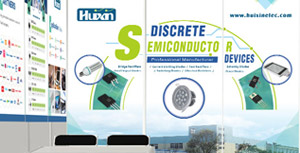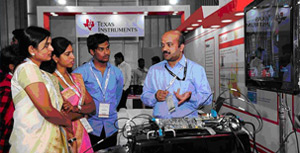HuiXin Electronic2015/11/13 16:26:49
Types of semiconductor diodes
There are several types of p–n junction diodes, which emphasize either a different physical aspect of a diode often by geometric scaling, doping level, choosing the right electrodes, are just an application of a diode in a special circuit, or are really different devices like the Gunn and laser diode and the MOSFET:
Normal (p–n) diodes, which operate as described above, are usually made of doped silicon or, more rarely, germanium. Before the development of silicon power rectifier diodes, cuprous oxide and later selenium was used. Their low efficiency required a much higher forward voltage to be applied (typically 1.4 to 1.7 V per "cell", with multiple cells stacked so as to increase the peak inverse voltage rating for application in high voltage rectifiers), and required a large heat sink (often an extension of the diode's metal substrate), much larger than the later silicon diode of the same current ratings would require. The vast majority of all diodes are the p–n diodes found in CMOS integrated circuits, which include two diodes per pin and many other internal diodes.
Avalanche diodes
These are diodes that conduct in the reverse direction when the reverse bias voltage exceeds the breakdown voltage. These are electrically very similar to Zener diodes (and are often mistakenly called Zener diodes), but break down by a different mechanism: the avalanche effect. This occurs when the reverse electric field applied across the p–n junction causes a wave of ionization, reminiscent of an avalanche, leading to a large current. Avalanche diodes are designed to break down at a well-defined reverse voltage without being destroyed. The difference between the avalanche diode (which has a reverse breakdown above about 6.2 V) and the Zener is that the channel length of the former exceeds the mean free path of the electrons, resulting in many collisions between them on the way out. The only practical difference between the two types is they have temperature coefficients of opposite polarities.
Cat's whisker or crystal diodes
These are a type of point-contact diode. The cat's whisker diode consists of a thin or sharpened metal wire pressed against a semiconducting crystal, typically galena or a piece of coal. The wire forms the anode and the crystal forms the cathode. Cat's whisker diodes were also called crystal diodes and found application in the earliest radios called crystal radio receivers. Cat's whisker diodes are generally obsolete, but may be available from a few manufacturers.
Constant current diodes
These are actually JFETs[19] with the gate shorted to the source, and function like a two-terminal current-limiting analog to the voltage-limiting Zener diode. They allow a current through them to rise to a certain value, and then level off at a specific value. Also called CLDs, constant-current diodes, diode-connected transistors, or current-regulating diodes.
Esaki or tunnel diodes
These have a region of operation showing negative resistance caused by quantum tunneling,[20] allowing amplification of signals and very simple bistable circuits. Due to the high carrier concentration, tunnel diodes are very fast, may be used at low (mK) temperatures, high magnetic fields, and in high radiation environments.[21] Because of these properties, they are often used in spacecraft.
Gunn diodes
These are similar to tunnel diodes in that they are made of materials such as GaAs or InP that exhibit a region of negative differential resistance. With appropriate biasing, dipole domains form and travel across the diode, allowing high frequency microwave oscillators to be built.
Light-emitting diodes (LEDs)
In a diode formed from a direct band-gap semiconductor, such as gallium arsenide, charge carriers that cross the junction emit photons when they recombine with the majority carrier on the other side. Depending on the material, wavelengths (or colors)[22] from the infrared to the near ultraviolet may be produced.[23] The forward potential of these diodes depends on the wavelength of the emitted photons: 2.1 V corresponds to red, 4.0 V to violet. The first LEDs were red and yellow, and higher-frequency diodes have been developed over time. All LEDs produce incoherent, narrow-spectrum light; "white" LEDs are actually combinations of three LEDs of a different color, or a blue LED with a yellow scintillator coating. LEDs can also be used as low-efficiency photodiodes in signal applications. An LED may be paired with a photodiode or phototransistor in the same package, to form an opto-isolator.
Laser diodes
When an LED-like structure is contained in a resonant cavity formed by polishing the parallel end faces, a laser can be formed. Laser diodes are commonly used inoptical storage devices and for high speed optical communication.
Thermal diodes
This term is used both for conventional p–n diodes used to monitor temperature due to their varying forward voltage with temperature, and for Peltier heat pumpsfor thermoelectric heating and cooling. Peltier heat pumps may be made from semiconductor, though they do not have any rectifying junctions, they use the differing behaviour of charge carriers in N and P type semiconductor to move heat.
Photodiodes
All semiconductors are subject to optical charge carrier generation. This is typically an undesired effect, so most semiconductors are packaged in light blocking material. Photodiodes are intended to sense light(photodetector), so they are packaged in materials that allow light to pass, and are usually PIN (the kind of diode most sensitive to light).[24] A photodiode can be used in solar cells, in photometry, or in optical communications. Multiple photodiodes may be packaged in a single device, either as a linear array or as a two-dimensional array. These arrays should not be confused with charge-coupled devices.
PIN diodes
A PIN diode has a central un-doped, or intrinsic, layer, forming a p-type/intrinsic/n-type structure.[25] They are used as radio frequency switches and attenuators. They are also used as large-volume, ionizing-radiation detectors and as photodetectors. PIN diodes are also used in power electronics, as their central layer can withstand high voltages. Furthermore, the PIN structure can be found in many power semiconductor devices, such as IGBTs, power MOSFETs, andthyristors.
Schottky diodes
Schottky diodes are constructed from a metal to semiconductor contact. They have a lower forward voltage drop than p–n junction diodes. Their forward voltage drop at forward currents of about 1 mA is in the range 0.15 V to 0.45 V, which makes them useful in voltage clamping applications and prevention of transistor saturation. They can also be used as low loss rectifiers, although their reverse leakage current is in general higher than that of other diodes. Schottky diodes are majority carrier devices and so do not suffer from minority carrier storage problems that slow down many other diodes—so they have a faster reverse recovery than p–n junction diodes. They also tend to have much lower junction capacitance than p–n diodes, which provides for high switching speeds and their use in high-speed circuitry and RF devices such as switched-mode power supply, mixers, and detectors.
Super barrier diodes
Super barrier diodes are rectifier diodes that incorporate the low forward voltage drop of the Schottky diode with the surge-handling capability and low reverse leakage current of a normal p–n junction diode.
Gold-doped diodes
As a dopant, gold (or platinum) acts as recombination centers, which helps a fast recombination of minority carriers. This allows the diode to operate at signal frequencies, at the expense of a higher forward voltage drop. Gold-doped diodes are faster than other p–n diodes (but not as fast as Schottky diodes). They also have less reverse-current leakage than Schottky diodes (but not as good as other p–n diodes).[26][27] A typical example is the 1N914.
Snap-off or Step recovery diodes
The term step recovery relates to the form of the reverse recovery characteristic of these devices. After a forward current has been passing in an SRD and the current is interrupted or reversed, the reverse conduction will cease very abruptly (as in a step waveform). SRDs can, therefore, provide very fast voltage transitions by the very sudden disappearance of the charge carriers.
Stabistors or Forward Reference Diodes
The term stabistor refers to a special type of diodes featuring extremely stable forward voltage characteristics. These devices are specially designed for low-voltage stabilization applications requiring a guaranteed voltage over a wide current range and highly stable over temperature.
Transient voltage suppression diode (TVS)
These are avalanche diodes designed specifically to protect other semiconductor devices from high-voltage transients.[28] Their p–n junctions have a much larger cross-sectional area than those of a normal diode, allowing them to conduct large currents to ground without sustaining damage.
Varicap or varactor diodes
These are used as voltage-controlled capacitors. These are important in PLL (phase-locked loop) and FLL (frequency-locked loop) circuits, allowing tuning circuits, such as those in television receivers, to lock quickly on to the frequency. They also enabled tunable oscillators in early discrete tuning of radios, where a cheap and stable, but fixed-frequency, crystal oscillator provided the reference frequency for a voltage-controlled oscillator.
Zener diodes
These can be made to conduct in reverse bias (backward), and are correctly termed reverse breakdown diodes. This effect, called Zener breakdown, occurs at a precisely defined voltage, allowing the diode to be used as a precision voltage reference. The term Zener diode is colloquially applied to several types of breakdown diodes, but strictly speaking Zener diodes have a breakdown voltage of below 5 volts, whilst avalanche diodes are used for breakdown voltages above that value. In practical voltage reference circuits, Zener and switching diodes are connected in series and opposite directions to balance the temperature coefficient response of the diodes to near-zero. Some devices labeled as high-voltage Zener diodes are actually avalanche diodes (see above). Two (equivalent) Zeners in series and in reverse order, in the same package, constitute a transient absorber (or Transorb, a registered trademark).
Other uses for semiconductor diodes include the sensing of temperature, and computing analog logarithms (see Operational amplifier applications#Logarithmic output).










